Expert Tips and Picks for Comfortable Hammock Camping
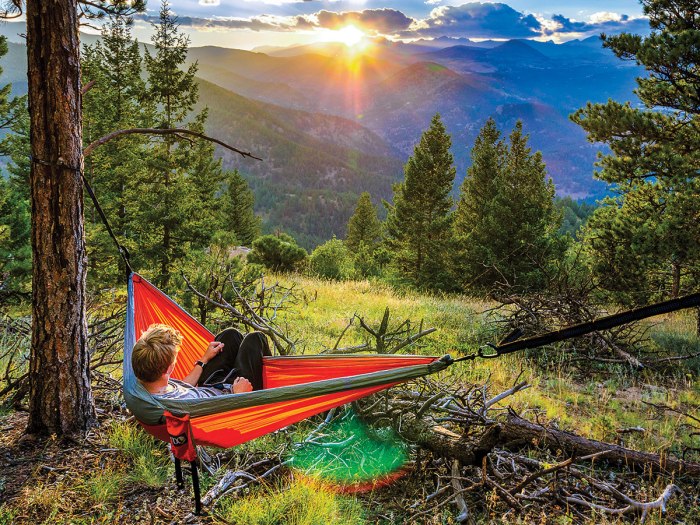
Hammock camping looks so fun, right? It can be a comfortable alternative to tent camping for backpacking and drive-in campgrounds. If you’re going to try it, do it right with these expert tips and picks for the best gear.
PROS AND CONS OF HAMMOCK CAMPING
For starters, understand the pros and cons of hammock camping.
PROS:
- If you like being suspended in the air, hammock camping offers super comfort.
- Whether rocky, uneven, muddy or wet, the ground doesn’t matter.
- Done right, sleeping in a hammock can be warm, dry and quiet.
- You get a great view of the stars on a clear night.
CONS:
- Stringing up a hammock requires a pair of sturdy trees an appropriate distance apart, whose trunks are not blocked by thick boughs. This is not easy or possible in all environments.
- A hammock slopes toward the middle in a banana shape, which some people find uncomfortable — especially those who shift a lot in their sleep.
- Your bed sways with every slight movement, which isn’t appealing to everyone.
- In sustained rain, a hammock doesn’t offer shelter for two or more people to stay dry together in camp, and it offers little space for one person to move around if sheltering for hours from rain.
Try sleeping in a hammock in your yard before buying all the gear and making plans to hammock camp on a backpacking trip.
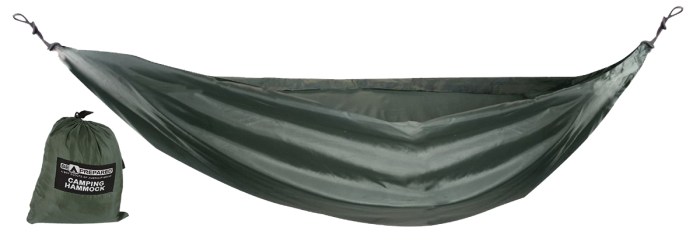
The BSA SINGLE PERSON HAMMOCK WITH STRAPS ($25, scoutshop.org) offers a basic setup that is large enough for most people and versatile enough for backpacking. If you’re experimenting with hammock camping, this is a sure pick at a bargain price. 10 oz.
TIPS FOR SLEEPING IN A HAMMOCK
- Hang the hammock at sitting height no more than 3 feet above the ground and sagging at a 30-degree angle. Don’t make it extremely taut, which can create a confining “cocoon effect” and cause you to flip and fall out of the hammock.
- Lie in it at a diagonal angle to reduce how much the hammock sags and envelops you. This isn’t always possible in the lightest, narrowest hammocks, so know what you’re getting before buying.
- You’ll need insulation from cold air and wind below the hammock, but many air mattresses will crease uncomfortably in a hammock. Find one that fits well, or forego an air mat for an underquilt.
- In wet weather, string the hammock as close to the ground as possible without touching it, and pitch your tarp’s apex close overhead.
- Tie strings, known as “drip lines,” to the strap attaching each end of a hammock to trees, with the two ends of each string hanging down. This way, any rain or water running down the straps drips from those cords rather than running into and soaking your hammock.
- Avoid setting up a hammock on dead trees or below dead branches that could fall on you, and always follow safety rules when hammock camping.
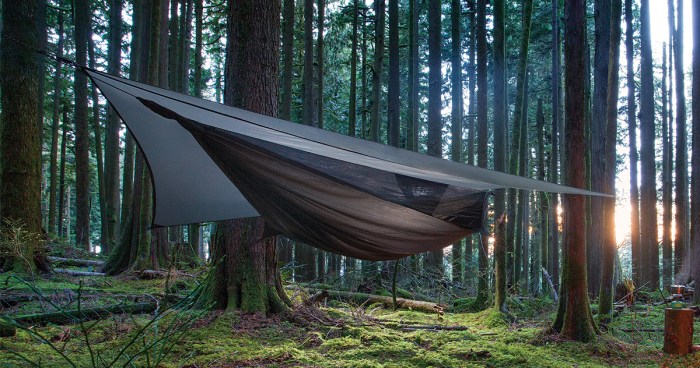
The HENNESSY HAMMOCK SCOUT CLASSIC ($100, hennessyhammock.com), designed for anyone up to 5 feet, 8 inches tall and 200 pounds, comes with an asymmetrical rainfly, making it an exceptional value in a first camping hammock. It has a structural ridge line, which helps it maintain its shape and make it easier to set up correctly. Hennessy stitches its hammocks asymmetrically to create a level bed for more comfortable sleeping. 2 lbs. 6 oz.
HAMMOCK SAFETY RULES
- Follow the manufacturer’s instructions for hanging distances.
- Hang hammocks in secure locations, such as to trees or solid posts. Never attach a hammock to something that could move.
- Fasten and check all knots before getting into a hammock.
- Never “stack” hammocks one above another.
- Hammocks should not be hung so the lowest point is more than 3 feet above the ground. The higher you are, the greater the chance to hurt yourself if you fall.
- Do not hang a hammock above water.
- Never swing or stand in a hammock.
- Do not use a hammock that has frayed or damaged ropes. Use only the manufacturer’s replacement ropes.
- Do not put more weight in a hammock than is recommended by the manufacturer.
- If you are using living trees, take care not to damage the outer bark.
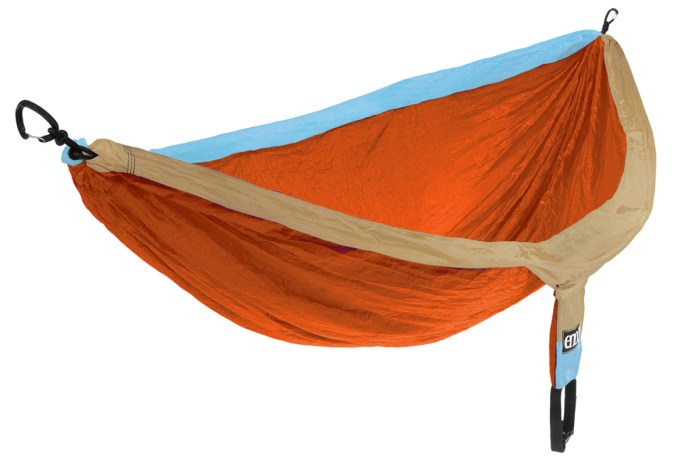
A simple, lightweight nylon hammock like the ENO DOUBLENEST HAMMOCK ($70, scoutshop.org), which is made for two people, provides more comfortable width for one person than many hammocks. It’s lightweight and very packable for backpacking but also made with durable 70-denier nylon. 1 lb. 3 oz.
THE NECESSARY HAMMOCK GEAR
A thin nylon hammock provides virtually no protection from the wind and cold. Since most exposure comes from below, you will need insulation under your hammock for warmth in temperatures below about 70 degrees. That’s generally in the form of a sleeping bag or underquilt, the latter designed to hang below a hammock. A relatively roomy sleeping bag that ventilates at the foot end lets you rig the hammock inside the bag, eliminating the need for an underquilt, thus reducing your system’s weight and cost.
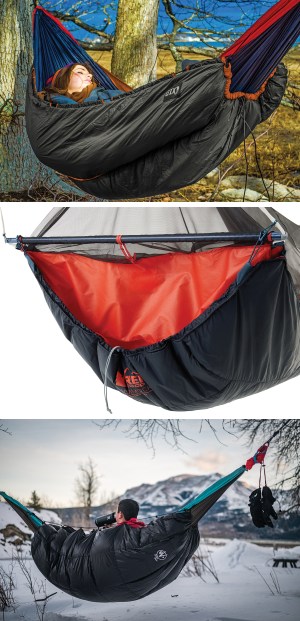 There are underquilts that perform well, like the ENO VULCAN ($175, 1 lb. 14 oz.), made with warm, packable synthetic PrimaLoft insulation and rated to 30-40 degrees, or the REI CO-OP HAMMOCK UNDERQUILT ($100, 1 lb. 10 oz.). The OUTDOOR VITALS AERIE 20 ($150, 2 lbs. 4 oz.) zips over the top of a hammock to fully enclose your nest in a pod system, enhancing warmth and potentially eliminating the need for a bag.
There are underquilts that perform well, like the ENO VULCAN ($175, 1 lb. 14 oz.), made with warm, packable synthetic PrimaLoft insulation and rated to 30-40 degrees, or the REI CO-OP HAMMOCK UNDERQUILT ($100, 1 lb. 10 oz.). The OUTDOOR VITALS AERIE 20 ($150, 2 lbs. 4 oz.) zips over the top of a hammock to fully enclose your nest in a pod system, enhancing warmth and potentially eliminating the need for a bag.
Lastly, a tarp is needed overhead to protect you from rain and, when angled properly, from wind. It also traps some heat from your body underneath it, similar to a tent, effectively providing some insulation.
The SEA TO SUMMIT HAMMOCK TARP ($150, 12 oz.), made with ultralight 15-denier siliconized/PU-coated nylon, uses a five-point design and measures almost 12 feet by more than 9 feet, easily angled for weather protection.
HENNESSY HAMMOCK offers a variety of tarp models ($50-$140), which also can be used alone for tarp camping.
If your hammock does not come with them, get non-stretching hammock straps, which wrap securely around a tree trunk and are adjustable for controlling the height of the hammock off the ground. They also prevent damage to a tree’s bark that can be caused by cord or rope.
If you’re heading out in bug season, you’d better have protective bug netting over your hammock. Some netting is designed for specific hammock models. Some camping hammocks come with integrated bug netting; buy that type if you’re consistently camping in buggy places, but if only occasionally, get a separate bug netting to avoid carrying unnecessary gear.
If backpacking, note the weight and bulk of your entire hammock system’s components, which can run anywhere from about 3-5 pounds or more — a big difference.
Finally, set up your hammock system at home before taking it out in the backcountry. Setup can be very time-consuming the first few times.
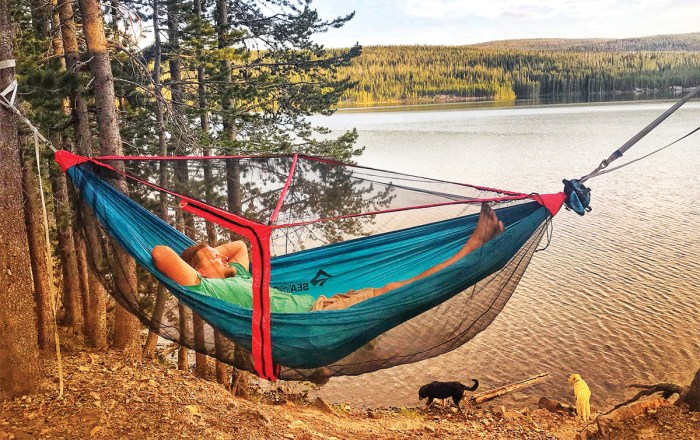
The SEA TO SUMMIT SINGLE PRO HAMMOCK BUNDLE ($95, seatosummitusa.com, 1 lb. 4 oz.) includes a durable (70-denier), water-resistant, spacious lightweight hammock with plated-steel buckles, plus 10-foot-long straps. The hammock pairs with the SEA TO SUMMIT HAMMOCK BUG NET ($70, 13 oz.), which has a collapsible spreader pole that creates a spacious interior, plus a wide zippered doorway. And the setup can include Sea to Summit’s ULTRA-SIL NANO TARP PONCHO ($110, 8 oz.), which can be used as a shelter for the hammock or a rain poncho that fits over a large backpack.
I really want a hammock thanks for the begging tips
The easiest way to get that 30 degree sag, is to hold your hand as if forming a gun; adjust the ropes until you touch it with your finger and thumb tips.
Tying anything to a tree is against the rules of most campgrounds and would be unethical on all public lands (Leave No Trace!).